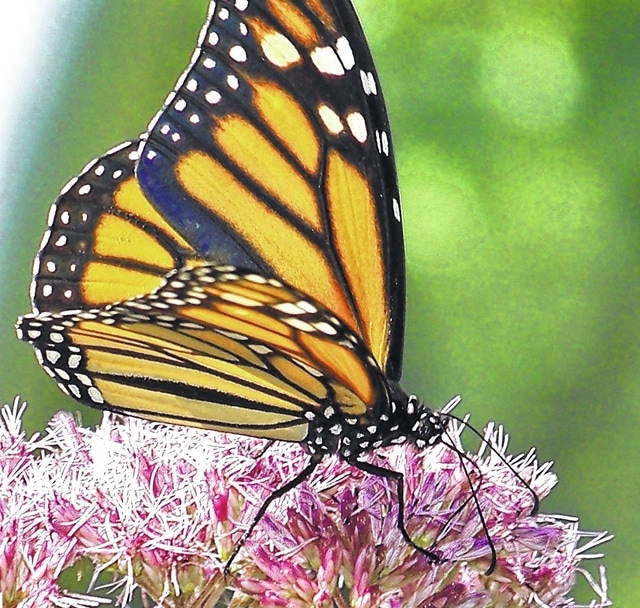
There are numerous migratory insects, including many moth and butterfly species. However, because of the Monarch’s large size and conspicuous coloration, its migration is the most obvious of our butterflies.
Monarch populations have declined alarmingly in recent years. The wintering population in Mexico was at its lowest recorded level in winter 2013-2014, and many observers reported seeing few if any Monarchs in eastern North America in summer and fall of 2013. The two next lowest wintering population levels were recorded within the last decade.
Experts estimate that the eastern population of Monarchs has diminished by 90 percent over the past 20 years. Scientists who study Monarchs cite several causes for population declines: 1) Habitat loss in the Mexican oyamel fir forests where Monarchs overwinter. 2) Weather events in their wintering grounds and during their northbound migration. The mortality caused by storm events in 2010 was thought to be 50 percent. 3) A precipitous decline in milkweeds in much of eastern North America.
The U.S. Fish and Wildlife Service has designated a narrow strip of land running from western Pennsylvania through Ohio (including Fayette County) to northern Missouri/southern Iowa as a Monarch Butterfly National Conservation Priority. Depending on the length of the season, which can be dictated by weather, Monarchs might have from two to four different broods in Ohio.
The adults produced from the last hatch will make an incredible journey to high elevation oyamel fir forests in central Mexico. This journey might entail traveling nearly 2,000 miles, one way. Once in Mexico, the butterflies congregate in massive numbers in a very few favored locales. Roosting trees are blanketed with butterflies, creating one of North America’s greatest natural spectacles. Northward migration reaches the U.S. in early March. Females lay eggs on emerging milkweeds throughout most of the southern U.S. The offspring of this first brood then colonize the remainder of the breeding range in eastern North America.
The Monarch Butterfly Journey North website reports, “The number of monarchs overwintering in Mexico for the 2015/2016 winter has increased dramatically from the record lows of the past three years, though the population remains 32 percent below the historic average. This year’s population contains 200 million monarchs clustered on 10 acres compared to a long-term average of 300 million and a peak of one billion. Favorable breeding conditions in summer 2015 are credited for the substantial increase.”
However, a winter storm of historic proportions recently struck the monarch sanctuaries in Mexico. “There is no word yet about how the monarchs were affected. The sequence of events is of particular concern. The storm began with rain and was followed by hail, snow, and sub-freezing temperatures. The butterflies are more susceptible to mortality from freezing when wet. Photos from El Rosario Sanctuary show trees within the sanctuary core zone toppled by the strong winds. Spring migration from Mexico was imminent but mass departure had evidently not yet occurred meaning the full population was in the storm’s path.”
“Local citizens can help the Monarchs by planting a pollinator plot that includes milkweed plants,” said Brigitte Hisey, Natural Resource Specialist at the Fayette Soil & Water Conservation District (FSWCD). Monarchs depend on milkweeds as host plants. The butterflies deposit eggs on milkweed plants, which then provide nutrition for the caterpillar phase of the butterfly’s life cycle. Plants in the milkweed family contain poisons known as cardiac glycosides, which render them unpalatable to most insects. Monarch caterpillars, and a handful of other insects, have evolved the ability to assimilate milkweed toxins. As the caterpillars, and subsequently the butterflies, sequester these toxic compounds in their bodies, they become distasteful to many predators. While milkweeds were long placed in their own family, they are now generally considered a subfamily of the much larger dogbane family. There are 17 native species in this group in Ohio, and Monarchs will use at least 13 of them as host plants.
“FSWCD is currently holding a Native Plant Sale. Milkweed plugs are available for $2 each. Planting success is much higher with plugs than with seeds. We also have four different kits of plants; Xerces Society Pollinator, Wetland, Butterfly/Bird, and Rain Garden. Each kit contains 50 plants of various species and sells for $100. Additionally, we offer a Butterfly Seed Mix. The deadline to place an order is March 24. Order forms may be picked up at the FSWCD office in the Fayette Ag Center, 1415 US 22 SW, Suite 500, Washington Court House, or visit us on Facebook.” Contact Brigitte Hisey at 740-636-0279 or [email protected] for more information.
Information from “Milkweeds and Monarchs”, Publication 5474 (0115), Ohio Department of Natural Resources Division of Wildlife.


